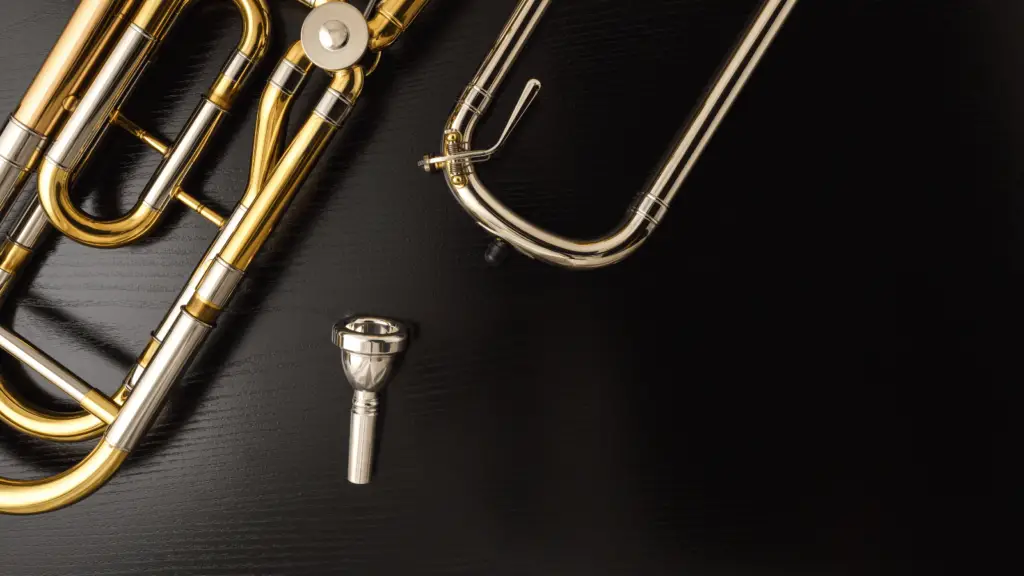Putting a trombone together looks like a tough task for those who’ve never done it before, but after a couple of times doing it, it’s quite easy.
In this post, I’ll go the steps I and many other music teachers have used for years to teach people how to set up a trombone.
Let’s dive in!

Table of Contents
Steps For How To Set Up A Trombone
#1 Put The Case On Stable Ground Or Surface
Take your case and lay it flat on the ground or a table that doesn’t move. You’d feel terrible if you opened the case to let the trombone drop on the ground!
Often, the label faces up when opening the case.
#2 Open The Case And Remove The Slide
The latches are different by make, so you’ll have to figure out how to undo the latches on your own (I believe in you!).
Open the case up all the way and take a look at the parts. Again, each case is different, so the different parts may be stored in different ways.
We’re looking for the slide of the trombone now. It’s a long U-shape with a bar going across the middle on one end.
The bell may also have a U-shape to it, but the bell is the end with the large opening that flares out. We don’t need this yet.
Remove the slide once you locate it. Double-check the slide lock is holding the inner slide and outer slide together. Often, this is a little turning part near the slide brace (the middle part).
Hold the slide perpendicular with the ground, so the two opening are facing up and the U part is facing the ground.
#3 Attach The Bell To The Slide
Remove the bell and line up the opening on the slide that has the threads to attach the bell. Align and attach the smaller end of the bell part to it.
As you tighten the parts to each other, adjust the angle of the slide and bell. They need to be 90 degrees with each other with the slide going off to the right when the large bell end is up.
Ensure the bell-slide connection is finger-tight and not wiggly as you move it around.
#4 Insert The Mouthpiece
Take your mouthpiece and insert the smaller end into the remaining slide opening.
Give it a slight twist when you put it in to ensure a solid connection through friction.
If the mouthpiece is too big to fit or it’s too small and keeps spinning, you have the wrong bore mouthpiece.
Check out our complete guide to the best trombone mouthpieces for more info to help you pick the right one.
At this point, you’re technically done, but I’d like to offer one more bonus step that most guides skip completely.
#5 Lubricate The Slide (Optional)
Your slide is how you change notes, so keeping it working smoothly is critical! Before you even play, I encourage you to lubricate it a little bit.
Taking care to hold your slide braces, undo the slide lock to release the inner slide. Let it move out, but keep a hand on it so it doesn’t fall all the way out.
Take a spray bottle with water and give the length of the slide a quick spritz.
Now, move the slide in and out to distribute the moisture.
If you notice it still doesn’t move well, you may need to do a deeper clean.
For a full guide, check out our post on how to clean a trombone slide.
How To Dissemble Or Take Apart A Trombone
Taking a trombone apart is the same as putting it together, just in reverse order.
Make sure the slide lock is on!
Remove the mouthpiece, then take the bell off and put it away.
Finally, put the slide in the right place. Close the case and latch it, and you’re on your way!
Commonly Asked Questions Related To Trombone Assembly
How Do You Hold A Trombone?
The trombone is held in a balanced position between the left and right hands. The left hand grips the brace located near the bell, fingers wrapped around the slide cross bar for support.
Thumb rests on the brace behind the mouthpiece.
Meanwhile, the right hand, pinching the movable brace with two/three fingers and a thumb, moves the slide in a smooth horizontal motion.
It’s important to maintain a relaxed posture to avoid strain and facilitate optimal playing performance.
Is Trombone Easy For Beginners?
Learning to play the trombone can be a challenge for beginners, as it requires mastering several skills simultaneously, including breath control, lip tension, slide positions, and reading music.
Unlike other instruments with defined notes like piano or guitar, trombone relies heavily on the player’s ear for pitch accuracy.
However, with proper instruction and regular practice, many beginners find the journey rewarding and achievable.
The learning curve varies from person to person, but patience and persistence always pave the way for improvement.
How Often Should You Oil A Trombone?
The frequency of oiling a trombone largely depends on usage and the player’s personal comfort. However, as a general guideline, it’s recommended to oil the trombone slide once a week.
Regular lubrication ensures smooth movement and extends the instrument’s longevity. If the trombone is played heavily or feels sluggish, oiling may need to occur more often.
Always remember to wipe off any excess oil to avoid buildup.
Do Trombones Need To Be Tuned?
Trombones need to be tuned, but they do tune on the fly as well.
Because they change pitch with their slide anyway, small adjustments are easy to make.
However, trombones need their fundamentals tuned to make everyone’s lives easier and limit the adjustments needed as they play.
For a full guide, check out our post on how to tune a trombone.
